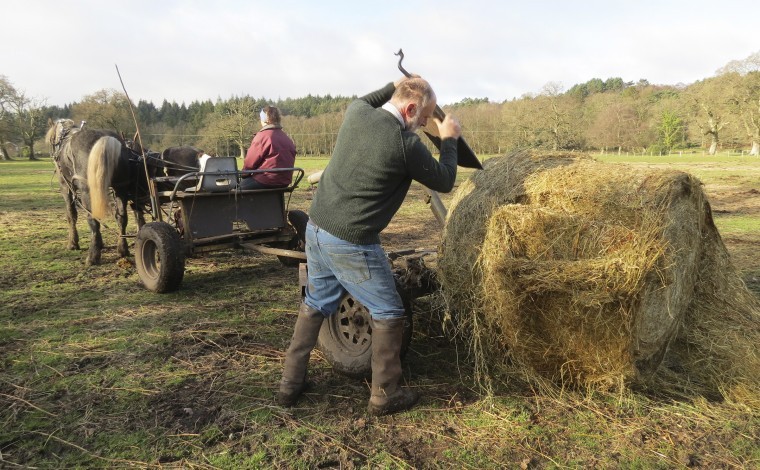Robert Sampson has lived at Harbridge Farm on the Somerley Estate in Hampshire all his life and was born there.
His family arrived in 1882 as tenants from Cranmore, which is 10 miles away, and before that from Spetisbury in Dorset, just over the border. “I have always worked horses, and my father never fully mechanised. It’s been an unbroken tradition which I have taken a step further by training horses for other people and training people to use horses.”
Because of the length of time that horses were last used in any numbers on farms, there is a lack of skill in handling and working them. “Things were taught and drummed into me as rote which I now have to pass on because what strikes me as absolute common sense has to be explained.” For example, when a horse is hitched onto a vehicle with blinkers, the bridle should not be taken off. “If it is removed, the horse can see the vehicle behind it and the driver no longer has any control because he has taken the bit out. People who are riding come into the yard and dismount and it doesn’t matter if they take the bridle off first or the saddle off, because they tie the horse. But if you do that with a vehicle, the horse moves and the vehicle moves and off they go and they can’t be stopped.”
When Mr Sampson and his father were training horses 30 years ago, people took their horses away and there was an old man in the village who could help and put things right. “Now, we have to make sure that the horse is as good as I can make them because in many cases we are selling them to total novices. If you are not careful, they have to learn the hard way why things are done the way they are.”
Percherons are a good breed to use with people and other breeds. They dominated the global draft horse market because they were docile and easy to use.”They were good converters of food so they would maintain condition on poor quality fodder. They also had good feet and clean legs.” From the breeding side, Percheron stallions are potent and produce Percheron characteristics in whatever they are put on. “I have crossed them with Shires, and although the foal isn’t pure, the traits are there.” By buying a Percheron stallion and using it on inferior stock, it is possible to have almost pure bred Percherons in three generations.
Mr Sampsom’s grandfather, who died in 1940, had Shires. Mr Sampson’s father was only 18 when that happened, and he ran the farm. But by the 1950s, the Shires he inherited were worn out. He had bought a tractor and implements in 1942 via lend lease, and worked the shires in conjunction with the kit.
As the shires grew older, the first Percherons were bought in 1951 from a clearance sale at Chivers Farms. “He chose Perecherons because at the time there was a lot of advertising in Farmers Weekly saying that if you wanted to stay with horses in agriculture, the Percheron was a much easier horse because they saved labour and would stay in order with a lot less help.”
Pictured: Robert Sampson chops haylage from the feeder cart which he uses for taking bales to up to 30 horses every day during the winter. He made the cart based on a similar design
<a href=”http://www.southeastfarmer.net/assets/flipbook/2017/SEF0317/SEF03Mar17.html#p=18>Click here to read the full visit




